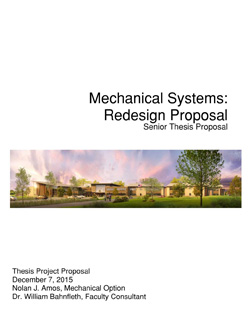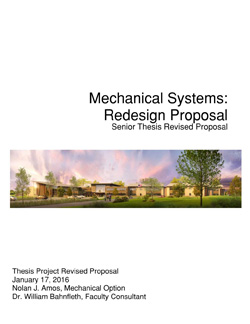| Phoenixville Early Learning Center | Nolan J. Amos |
| Phoenixville, PA | Mechanical Option |

Announcements
|
Thesis Proposal: The following is an overview of the depth and breadths of my Thesis Proposal. Please click on the icon to view the full report. Posted is the original proposal on the left and the revised proposal on the right.
Geothermal Heat Pumps with Energy Recovery Ventilator: Depth An alternate design consideration is geothermal heat pumps combined with the current energy recovery ventilator units. Geothermal heat pumps use the ground as a heat sink in the summer and a heat source in the winter. During summer months heat from the building is put into the ground and the fluid is then cooled from the ground temperature. In the winter months, when the ground is warmer than the outside air, the fluid is heated by the ground and can reduce loads on the heat pumps. This is possible due to stable year-round temperatures roughly twenty feet below the ground. Heat pumps would need to be changed from water source heat pumps to water to air heat pumps. Existing ERV units would remain to preheat the incoming outdoor air, allowing for even more energy savings. Tonnage and locations of the ERV units will be studied to assure they are compatible with the new system.
Centralized Air Handling Unit: Depth Centralized Air Handling Units consist of one modular unit that will heat, cool and distribute air to the building. Benefits include space saving, because there are not secular units spread throughout the building. There does however, need to be a large space either on the roof or behind the building to put the unit. Centralized Air Handling Units are also easy to service, because they are composed of one unit rather than chasing the problem around the building. Units are normally built with access doors making changing of filters and normal maintenance simple. Another positive is since the units are modular, they can be added to and removed if the loads in the building change. Variable Refrigeration Flow and Energy Recovery Ventiliators: Depth Variable Refrigerant Flow (VRF) systems allow design flexibility for additional units to be added onto the system in case of reconfiguration or building expansion. VRF systems have advanced maintenance and commissioning procedures that allow them to maintain settings and have reduced water treatment issues. Energy Efficiency also plays a large roll in the VRF system selection because there is no duct system to lose heat, which typically loses about 10 percent of the air’s heat in ductwork. VRF systems can provide simultaneous heating and cooling between different zones which provides a higher comfort rating for its occupants. Typically, to install VRF systems the initial cost is 5-20 percent higher than typical chilled water sources. Scheduling and Cost Impact on Construction: BreadthImplementation of a geothermal heat pump system will have adverse effects on the schedule and cost impact of construction for the Early Learning Center. Wells will need to be drilled, fitted with pipes, pumps and then refilled all in a concise time schedule. The wells also need a location near the school to bore the holes for the wells. In the breath analysis, the drilling of geothermal wells will be analyzed to consider the impact on the critical path. Factors to be evaluated are number of wells, well orientation (horizontal or vertical), location of wells, depth and length of wells, extra equipment required for digging or installing the wells, lifecycle cost analysis, and construction schedule. Addressing these main points allows for the analysis to address concerns on the feasibility of a geothermal heat pump system. Studying the construction impacts of a geothermal heat pump system allow for the full understanding of the consequences and benefits of choosing a geothermal heat pump system.
VRF Electrical Impacts: BreadthThe second breath will examine the impacts of a VRF heating and cooling system on the electrical system of the building. The analysis will include analyzing building loads to determine if the electrical load increases or decreases. Due to the new load, large changes in wire sizing could have a grand impact on cost because conduit sizing will also be effected. Then, a redesign of the electrical system will occur to match the new heating and cooling system. An electrical redesign will provide a basis for electrical comprehension and understanding for future projects. |
|
|
This page was last updated on April 25, 2016 by Nolan J. Amos and is hosted by the AE Department ©2016
Note: While great efforts have been taken to provide accurate and complete information on the pages of CPEP, please be aware that the information contained herewith is considered a work‐in‐ progress for this thesis project. Modifications and changes related to the original building designs and construction methodologies for this senior thesis project are solely the interpretation of Nolan J. Amos. Changes and discrepancies in no way imply that the original design contained errors or was flawed. Differing assumptions, code references, requirements, and methodologies have been incorporated into this thesis project; therefore, investigation results may vary from the original design.
Disclaimer: Renderings used are the property of SCHRADERGROUP architecture LLC


